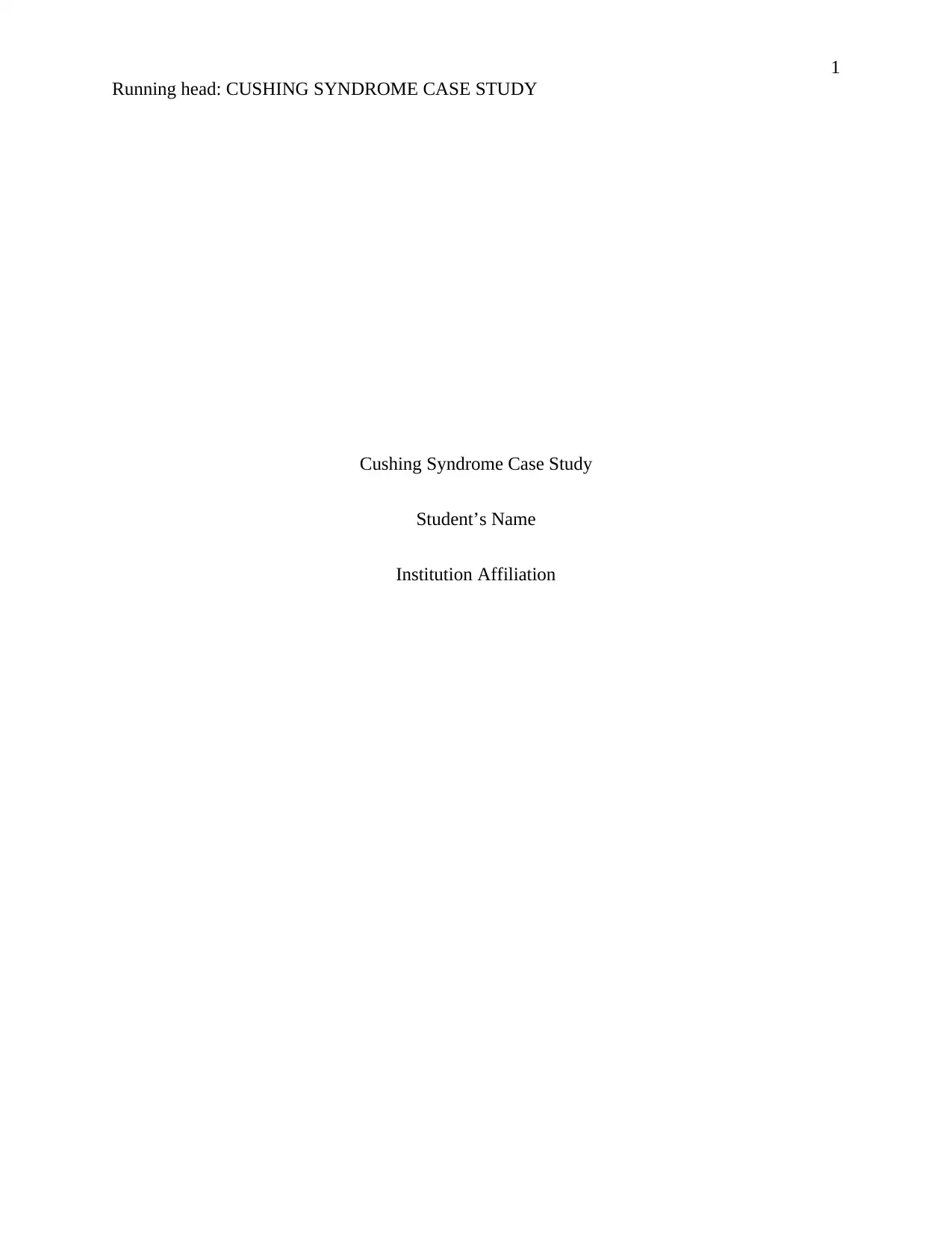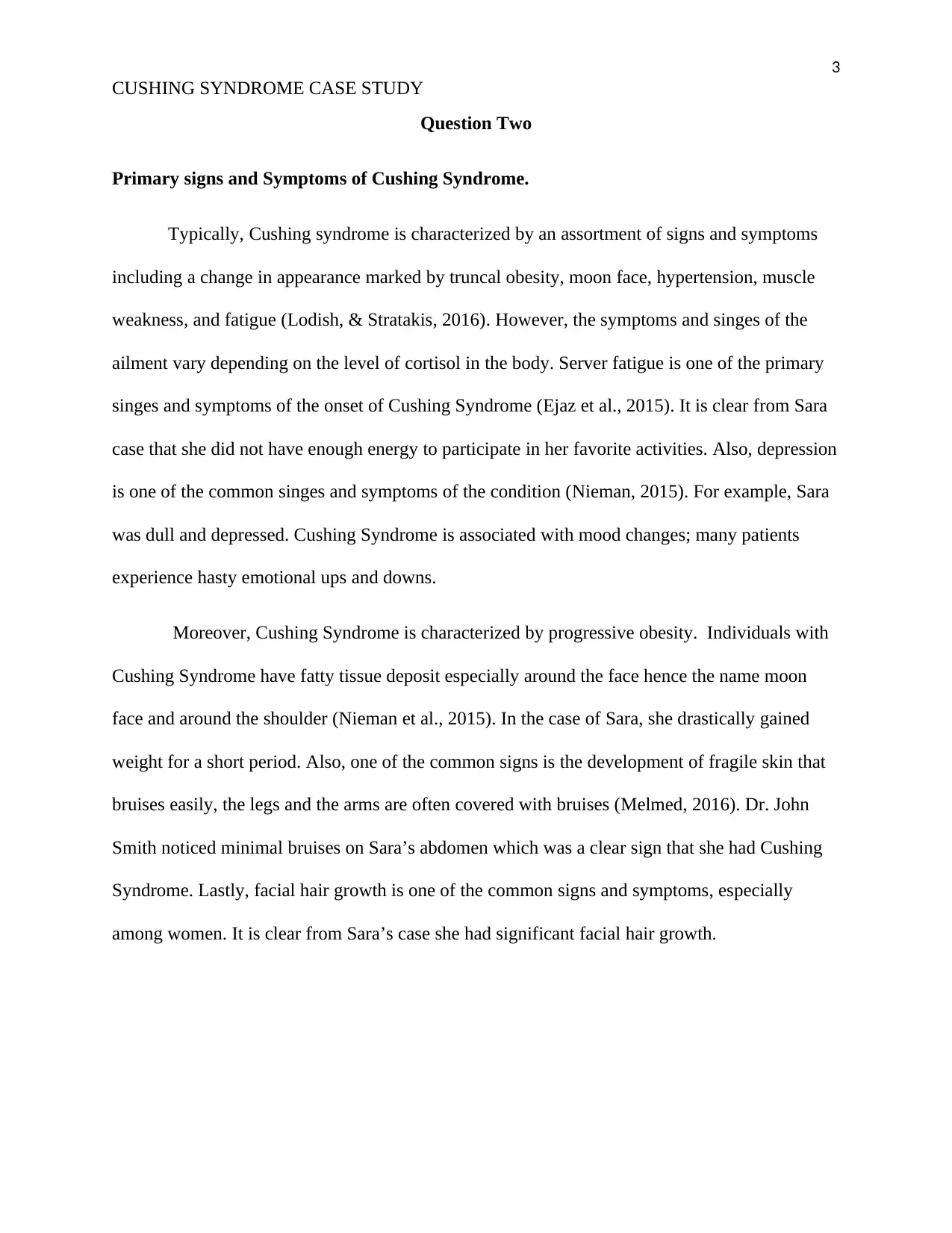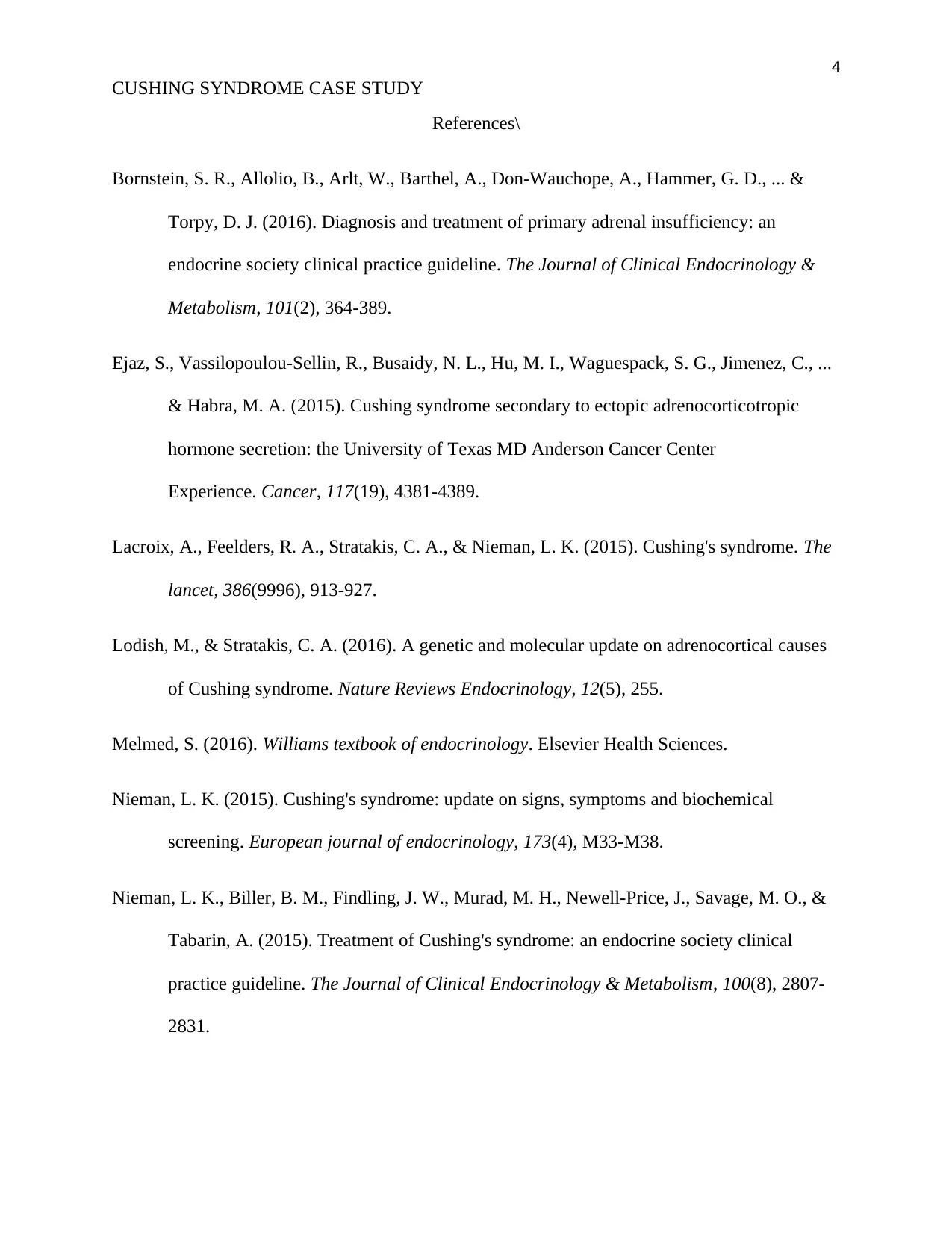Case Study: Understanding Cushing Syndrome - A Comprehensive Analysis
VerifiedAdded on 2023/06/08
|5
|1041
|84
Case Study
AI Summary
This case study examines Cushing Syndrome, a disorder characterized by excessive cortisol levels in the body. The assignment explores the causative factors, primarily focusing on prolonged corticosteroid use, specifically betamethasone for asthma. It details the pathophysiology, explaining how the adrenal gland and pituitary gland are involved. The study highlights primary signs and symptoms, including fatigue, depression, weight gain (moon face and truncal obesity), skin fragility, and facial hair growth. The analysis references key studies and clinical guidelines to support the findings, offering a comprehensive understanding of the disease and its manifestations. The case study also touches on the impact of the condition on the patient's physical and emotional well-being.

1
Running head: CUSHING SYNDROME CASE STUDY
Cushing Syndrome Case Study
Student’s Name
Institution Affiliation
Running head: CUSHING SYNDROME CASE STUDY
Cushing Syndrome Case Study
Student’s Name
Institution Affiliation
Paraphrase This Document
Need a fresh take? Get an instant paraphrase of this document with our AI Paraphraser

2
CUSHING SYNDROME CASE STUDY
Question One
Causative Factors and Pathophysiology of Cushing Syndrome
Cushing syndrome refers to an abnormal ailment instigated by a high level of
corticosteroids in the body either due to continued use of corticosteroid medication or
hyperfunction of the adrenal gland (Bornstein et la., 2016). Typically, the illness is characterized
by some changes in the body appearance, for example, muscle weakness, fatigue, moon face,
hypertension and truncal obesity. Recent studies have shown that Cushing Syndrome condition
occurs more often among women between age 22 to 50 years (Lacroix, Feelders, Stratakis, &
Nieman, 2015). Cortisol is a hormone in the body responsible for stress response. In a healthy
human being the anterior pituitary gland reevaluates adrenocorticotropic hormone (ACTH)
which stimulates the release and production of cortisol hormone (Sharma, Nieman, & Feelders,
2015). However, there are cases where the body is unbaled to regulate the release of the hormone
thus, overproduction. For instance, when an individual encounter a stressful situation the body
releases additional cortisol hormone to respond to the situation.
Cortisol hormone plays a critical in a person’s body as it keeps cardiovascular system to
function normally and it helps to regulate a person’s blood pressure (Bornstein et la., 2016). One
of the causative factors of the ailment is the prolonged use of corticosteroid medication like Oral
corticosteroid. Also, the illness can be caused by an individual body’s overproduction of cortisol
hormone. In the case of Sara, it is clear that Cushing Syndrome occurred because of prolonged
use of betamethasone for her asthma. Sara’s medication is Oral corticosteroid in nature. Usually,
the doses required to treat asthma are higher than the amount of cortisol a person body uses each
day. Therefore, Sara developed Cushing Syndrome.
CUSHING SYNDROME CASE STUDY
Question One
Causative Factors and Pathophysiology of Cushing Syndrome
Cushing syndrome refers to an abnormal ailment instigated by a high level of
corticosteroids in the body either due to continued use of corticosteroid medication or
hyperfunction of the adrenal gland (Bornstein et la., 2016). Typically, the illness is characterized
by some changes in the body appearance, for example, muscle weakness, fatigue, moon face,
hypertension and truncal obesity. Recent studies have shown that Cushing Syndrome condition
occurs more often among women between age 22 to 50 years (Lacroix, Feelders, Stratakis, &
Nieman, 2015). Cortisol is a hormone in the body responsible for stress response. In a healthy
human being the anterior pituitary gland reevaluates adrenocorticotropic hormone (ACTH)
which stimulates the release and production of cortisol hormone (Sharma, Nieman, & Feelders,
2015). However, there are cases where the body is unbaled to regulate the release of the hormone
thus, overproduction. For instance, when an individual encounter a stressful situation the body
releases additional cortisol hormone to respond to the situation.
Cortisol hormone plays a critical in a person’s body as it keeps cardiovascular system to
function normally and it helps to regulate a person’s blood pressure (Bornstein et la., 2016). One
of the causative factors of the ailment is the prolonged use of corticosteroid medication like Oral
corticosteroid. Also, the illness can be caused by an individual body’s overproduction of cortisol
hormone. In the case of Sara, it is clear that Cushing Syndrome occurred because of prolonged
use of betamethasone for her asthma. Sara’s medication is Oral corticosteroid in nature. Usually,
the doses required to treat asthma are higher than the amount of cortisol a person body uses each
day. Therefore, Sara developed Cushing Syndrome.

3
CUSHING SYNDROME CASE STUDY
Question Two
Primary signs and Symptoms of Cushing Syndrome.
Typically, Cushing syndrome is characterized by an assortment of signs and symptoms
including a change in appearance marked by truncal obesity, moon face, hypertension, muscle
weakness, and fatigue (Lodish, & Stratakis, 2016). However, the symptoms and singes of the
ailment vary depending on the level of cortisol in the body. Server fatigue is one of the primary
singes and symptoms of the onset of Cushing Syndrome (Ejaz et al., 2015). It is clear from Sara
case that she did not have enough energy to participate in her favorite activities. Also, depression
is one of the common singes and symptoms of the condition (Nieman, 2015). For example, Sara
was dull and depressed. Cushing Syndrome is associated with mood changes; many patients
experience hasty emotional ups and downs.
Moreover, Cushing Syndrome is characterized by progressive obesity. Individuals with
Cushing Syndrome have fatty tissue deposit especially around the face hence the name moon
face and around the shoulder (Nieman et al., 2015). In the case of Sara, she drastically gained
weight for a short period. Also, one of the common signs is the development of fragile skin that
bruises easily, the legs and the arms are often covered with bruises (Melmed, 2016). Dr. John
Smith noticed minimal bruises on Sara’s abdomen which was a clear sign that she had Cushing
Syndrome. Lastly, facial hair growth is one of the common signs and symptoms, especially
among women. It is clear from Sara’s case she had significant facial hair growth.
CUSHING SYNDROME CASE STUDY
Question Two
Primary signs and Symptoms of Cushing Syndrome.
Typically, Cushing syndrome is characterized by an assortment of signs and symptoms
including a change in appearance marked by truncal obesity, moon face, hypertension, muscle
weakness, and fatigue (Lodish, & Stratakis, 2016). However, the symptoms and singes of the
ailment vary depending on the level of cortisol in the body. Server fatigue is one of the primary
singes and symptoms of the onset of Cushing Syndrome (Ejaz et al., 2015). It is clear from Sara
case that she did not have enough energy to participate in her favorite activities. Also, depression
is one of the common singes and symptoms of the condition (Nieman, 2015). For example, Sara
was dull and depressed. Cushing Syndrome is associated with mood changes; many patients
experience hasty emotional ups and downs.
Moreover, Cushing Syndrome is characterized by progressive obesity. Individuals with
Cushing Syndrome have fatty tissue deposit especially around the face hence the name moon
face and around the shoulder (Nieman et al., 2015). In the case of Sara, she drastically gained
weight for a short period. Also, one of the common signs is the development of fragile skin that
bruises easily, the legs and the arms are often covered with bruises (Melmed, 2016). Dr. John
Smith noticed minimal bruises on Sara’s abdomen which was a clear sign that she had Cushing
Syndrome. Lastly, facial hair growth is one of the common signs and symptoms, especially
among women. It is clear from Sara’s case she had significant facial hair growth.
⊘ This is a preview!⊘
Do you want full access?
Subscribe today to unlock all pages.

Trusted by 1+ million students worldwide

4
CUSHING SYNDROME CASE STUDY
References\
Bornstein, S. R., Allolio, B., Arlt, W., Barthel, A., Don-Wauchope, A., Hammer, G. D., ... &
Torpy, D. J. (2016). Diagnosis and treatment of primary adrenal insufficiency: an
endocrine society clinical practice guideline. The Journal of Clinical Endocrinology &
Metabolism, 101(2), 364-389.
Ejaz, S., Vassilopoulou‐Sellin, R., Busaidy, N. L., Hu, M. I., Waguespack, S. G., Jimenez, C., ...
& Habra, M. A. (2015). Cushing syndrome secondary to ectopic adrenocorticotropic
hormone secretion: the University of Texas MD Anderson Cancer Center
Experience. Cancer, 117(19), 4381-4389.
Lacroix, A., Feelders, R. A., Stratakis, C. A., & Nieman, L. K. (2015). Cushing's syndrome. The
lancet, 386(9996), 913-927.
Lodish, M., & Stratakis, C. A. (2016). A genetic and molecular update on adrenocortical causes
of Cushing syndrome. Nature Reviews Endocrinology, 12(5), 255.
Melmed, S. (2016). Williams textbook of endocrinology. Elsevier Health Sciences.
Nieman, L. K. (2015). Cushing's syndrome: update on signs, symptoms and biochemical
screening. European journal of endocrinology, 173(4), M33-M38.
Nieman, L. K., Biller, B. M., Findling, J. W., Murad, M. H., Newell-Price, J., Savage, M. O., &
Tabarin, A. (2015). Treatment of Cushing's syndrome: an endocrine society clinical
practice guideline. The Journal of Clinical Endocrinology & Metabolism, 100(8), 2807-
2831.
CUSHING SYNDROME CASE STUDY
References\
Bornstein, S. R., Allolio, B., Arlt, W., Barthel, A., Don-Wauchope, A., Hammer, G. D., ... &
Torpy, D. J. (2016). Diagnosis and treatment of primary adrenal insufficiency: an
endocrine society clinical practice guideline. The Journal of Clinical Endocrinology &
Metabolism, 101(2), 364-389.
Ejaz, S., Vassilopoulou‐Sellin, R., Busaidy, N. L., Hu, M. I., Waguespack, S. G., Jimenez, C., ...
& Habra, M. A. (2015). Cushing syndrome secondary to ectopic adrenocorticotropic
hormone secretion: the University of Texas MD Anderson Cancer Center
Experience. Cancer, 117(19), 4381-4389.
Lacroix, A., Feelders, R. A., Stratakis, C. A., & Nieman, L. K. (2015). Cushing's syndrome. The
lancet, 386(9996), 913-927.
Lodish, M., & Stratakis, C. A. (2016). A genetic and molecular update on adrenocortical causes
of Cushing syndrome. Nature Reviews Endocrinology, 12(5), 255.
Melmed, S. (2016). Williams textbook of endocrinology. Elsevier Health Sciences.
Nieman, L. K. (2015). Cushing's syndrome: update on signs, symptoms and biochemical
screening. European journal of endocrinology, 173(4), M33-M38.
Nieman, L. K., Biller, B. M., Findling, J. W., Murad, M. H., Newell-Price, J., Savage, M. O., &
Tabarin, A. (2015). Treatment of Cushing's syndrome: an endocrine society clinical
practice guideline. The Journal of Clinical Endocrinology & Metabolism, 100(8), 2807-
2831.
Paraphrase This Document
Need a fresh take? Get an instant paraphrase of this document with our AI Paraphraser

5
CUSHING SYNDROME CASE STUDY
Sharma, S. T., Nieman, L. K., & Feelders, R. A. (2015). Cushing’s syndrome: epidemiology and
developments in disease management. Clinical epidemiology, 7, 281.
CUSHING SYNDROME CASE STUDY
Sharma, S. T., Nieman, L. K., & Feelders, R. A. (2015). Cushing’s syndrome: epidemiology and
developments in disease management. Clinical epidemiology, 7, 281.
1 out of 5
Related Documents
Your All-in-One AI-Powered Toolkit for Academic Success.
+13062052269
info@desklib.com
Available 24*7 on WhatsApp / Email
![[object Object]](/_next/static/media/star-bottom.7253800d.svg)
Unlock your academic potential
Copyright © 2020–2025 A2Z Services. All Rights Reserved. Developed and managed by ZUCOL.




